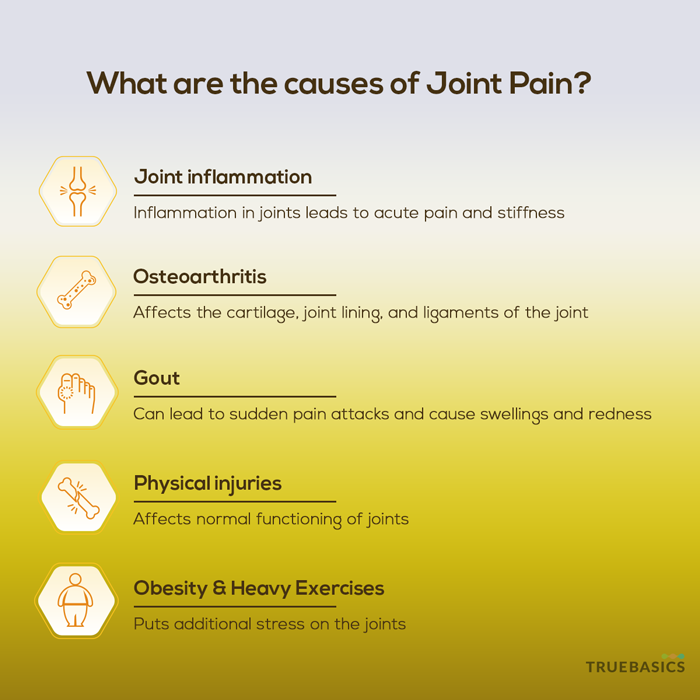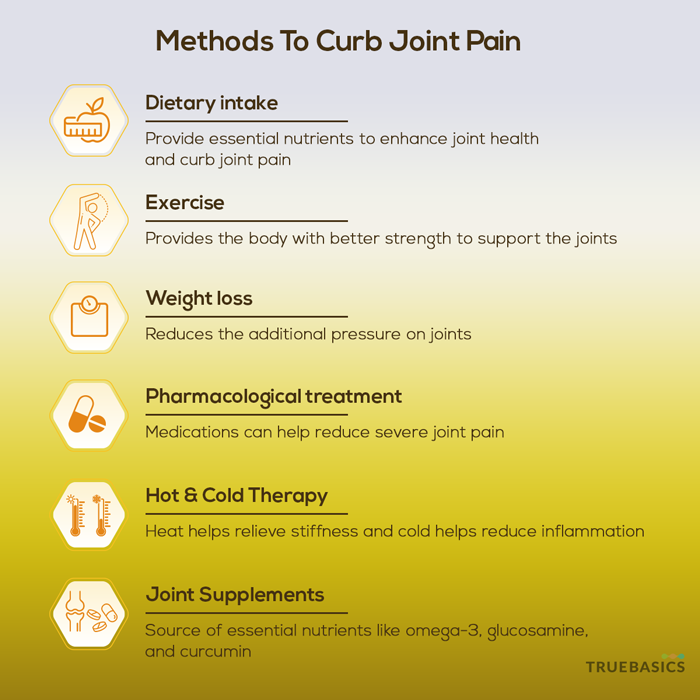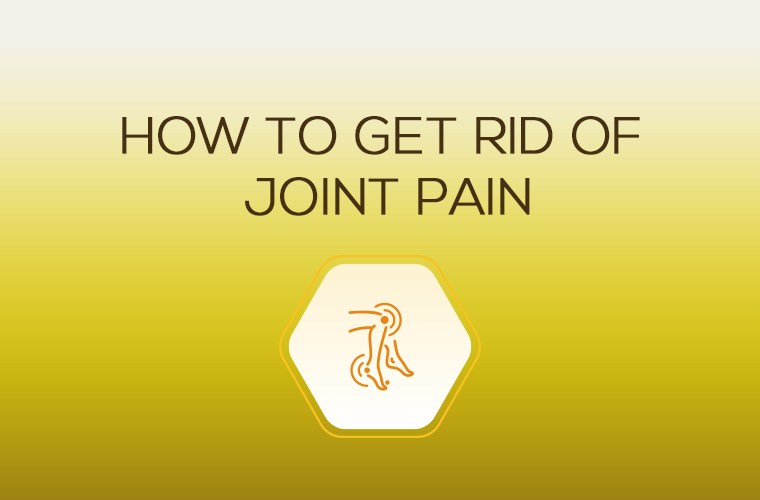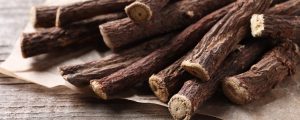Joints are one of the most important parts of the body, allowing body movement and flexibility. Joint pain is one of the most widespread issues which can severely hamper daily lifestyle. Regardless of whether the reason for joint pain is prolonged arthritis, a recent physical injury, or simply aging, even the most rudimentary tasks assume the shape of burdens. While most people take joint pain lightly, reaching for temporary measures, joint pain should demand your most urgent attention.
Knowing your Joints
Joints, constituting fibrous tissues and cartilages, are areas where two bones are attached to facilitate bodily movements. Joints are made up of:
- Ligaments – These are bands of tough elastic tissues around your joints. They connect bone to bone, give your joints support, and limit their abnormal movement.
- Synovial Fluid – This is the slippery fluid that fills most of the body’s joints. The joints occur where two separate bones intersect or overlap, but there are а few that don’t contain synovial fluid and have very limited movement, including the joints in between the vertebral discs.
- Synovial Membrane – It is the soft tissue found between the joint capsule and the joint cavity of synovial joints (joints found between the bones which move against each other). It secretes the synovial fluid, which fills the joint cavity and lubricates the joint.
- Cartilage – Cartilages are flexible, connective tissues. The ones present in the joints are called articular cartilage because the cartilage covers bones’ surfaces where they articulate or meet to form the joint.[1]
- Tendons – These are tough, fibrous connective tissues responsible for connecting muscles to the bone.[2]
- Bursas – These are fluid-filled sacs between bones, ligaments, or other nearby structures that help cushion the friction in а joint.
- Meniscus – This is the curved part of the cartilage in knees and other joints which helps in providing the gliding motion in the joints.
Joints can be either movable joints (such as elbow joint, knee joint), fixed joints (including joints that don’t move in adults, such as the ones in the skull), and joints that may my move а little, such as the vertebrae.
Keeping your joints healthy allows to not only run, walk, jump, play sports but also facilitate you in your day-to-day activities. People with arthritis resist regular physical activity or exercise because they fear it will increase pain or further damage their joints. The body is supposed to move, and our joints are meant to pave the way for it.
What is Joint Pain?
Joint pain, a common complaint, and something that doesn’t automatically trigger а hospital visit refer to discomfort, aches, and soreness in any of the body’s joints. They may arise out of multiple factors that affect their normal functioning.
The term arthritis is often used to refer to any disorder that affects the joints. Even though the widespread belief is that arthritis only affects older people, the truth is that arthritis affects young people too.
Different disorders tend to affect different joints and therefore finding the cause of joint pain requires knowledge of the nature and location of the pain. When multiple joints are involved, some disorders are more likely to affect the same joint on both sides of the body than other disorders, something which is termed symmetric arthritis. Moreover, in some disorders, an attack of arthritis remains in the same joints throughout the attack. In some cases, called migratory arthritis, arthritis moves from joint to joint. [3]
Causes of Joint Pain
Pain in the joints could be attributed to multiple. It could range from inflammation, а simple physical injury affecting any of the ligaments, bursae, or tendons surrounding the joint, or inflammation, or a result of additional stress on the joints.
1. Joint Inflammation
This is one of the most common causes of joint pain. Inflammation is the body response to foreign invaders such as infection, injury or toxins. However, chronic inflammation can result in Inflammation in joints leading to stiffness and acute pain, which practically renders it immobile.
2. Osteoarthritis
Osteoarthritis is generally associated with a decline in joint health due to aging. Aging causes the water content in the cartilage to increase and degenerates the protein content of the cartilage. This causes the loss of cartilage cushion between the bones at the joints and that leads to friction, which then causes swelling and joint pain.
3. Gout
Gout affects the large joint of your big toe but can occur in almost any joint. Among the affected joints are the ankles, knees, elbows, wrists, and fingers. This can lead to sudden, severe pain attacks, and even cause swellings and redness.
4. Physical Injuries
Physical injuries to the joint can cause pain. This can be due to sprains, strains, dislocations, ligament tears, bursts, etc. Patients with chronic joint pains, in many cases, have been found to have a history of physical injury or ailment.[4]
5. Obesity & Heavy Intensity Exercises
Almost all of our body weight is carried by our joints. Additional weight puts more stress on the body joints and it becomes for your joints to support the body properly. Therefore, people who have a high body mass index (BMI) are more susceptible to joint pain. Obese people also tend to do lesser physical activities, which causes their muscles to become weak, and thus accelerates joint pain.[5]
People or young adults who perform high intensity workouts or heavy sports activity are also prone to joint pain. This may be due to additional stress on joints as well as an additional risk of physical injuries that occur while performing those exercises.
6. Bone Cancer
Bone cancer occurs most often in the long bones of the arms and legs. Joint pain is one of the symptoms of bone cancer. However, it is not the only symptom and relevant tests can reveal the presence of bone cancer.

When Does Joint Pain Become an Issue?
While joint pain could arise out of daily lifestyle, physical injury, heavy exercises or because of medical issues. You should watch out for the following warning signs to begin taking measures to cure and curb these joint pains.
- Noticeable Redness near the joints
- Swelling near the joints
- An involuntary limping while walking
- Loss of range of motion of the joint
- Stiffness in joints
- Joint weakness
- Tenderness of the inflamed joint can be present with or without pain
- When arthritis affects the small joints in fingers, there can be loss of hand grip and grip strength of the hand associated with stiffness
- When large joints are involved, such as the knee, there can be loss of cartilage with limitation of motion from the joint damage
In case these symptoms are getting chronic, you might be facing something serious and need to bring about changes in your lifestyle and diet.
Solutions to Curb Joint Pain
Check out certain measures that can help you relieve joint pain –
1. Dietary Intake
Your food and nutrition dietary intake can positively influence your joint pain. Inclusion of omega-3 in a diet can help you reduce joint inflammation and mitigate the consequent joint pain. Found in fatty fishes, fish oil, nuts and seeds, Omega-3 has anti-inflammatory properties and helps reduce inflammation. Studies have reported that omega-3 can help people with osteoarthritis and rheumatoid arthritis.[6]
Turmeric, a common household food item, is a beneficial ingredient that you can add to your diet to curb joint pain. Turmeric contains curcumin, a compound that has anti-inflammatory properties which can help reduce joint pain in patients suffering from rheumatoid arthritis.
UC-II is undenatured type-II collagen obtained from chicken sternum. It helps in rebuilding healthy joints and is used to support day-to-day joint health as it improves mobility and flexibility. The undenatured type-II collagen is helpful in reducing the levels of inflammatory cytokines which decreases the occurrence and severity of arthritis [7]. UC-II can be taken as supplements along with your daily diet.
2. Exercise
Contradictory to popular belief, exercising is a simple and brilliant way of reducing joint pain. The chances of the joints being stiff will be considerably less if the body is active. Light intensity exercises such as walking, bicycling, swimming, strength training and stretching don’t exert undue pressure on joints. These exercises provide the body enough strength to better support the joints.
3. Weight Loss
Weight loss can prove beneficial for reducing joint pain in overweight patients. Reducing body weight reduces the pressure on the joints which in turn reduces joint pain and improves overall joint health.[8]
4. Hot & Cold Therapy
An inexpensive and effective way of reducing joint pain is to apply hot and cold to the affected joints. For heat therapy, you can soak your joints in a steaming tub or take a hot shower, apply hot water bags or cover your joints with a warm robe. Heat is said to relax your stiff, tense and sore joint muscles by stimulating blood flow and improving circulation. Heat also eases the motion between your joints.[9]
When there’s a burning sensation due to joint pain or arthritis, cold therapy is used. You can apply chilled water bags or ice packs on the affected joints. Cold therapy helps numb the areas affected by severe joint pain and helps reduce inflammation, which is a major cause of pain and stiffness. You can also use cold therapy to reduce swelling in the joint, which also helps bring down the joint pain.[10]
5. Joint Supplementation
There are several supplements available that provide your body with essential nutrients that can be effective in curbing joint pain. Omega-3 or fish oil supplements can help you reduce joint pain as well as maintain joint health. Their anti-inflammatory properties can help lower joint pain by reducing stiffness. Studies, involving hundreds of participants with Rheumatoid Arthritis, have reported that people have noticed a reduction in joint pain after taking Omega-3 supplements.[11]
Chondroitin supplements are also known to ease joint pain. Chondroitin supplements contain chondroitin sulfate made from animal cartilage and prove beneficial in reducing inflammation. Chondroitin also improves joint function and helps slows down the development of osteoarthritis.[12]
Glucosamine is another effective supplement, which can prove useful in retaining water in the cartilage, thus preventing any cartilage breakdown and help lubricate joints 11. You can also take curcumin supplements to heal joint pains as they have anti-inflammatory properties that are known to benefit in the case of rheumatoid arthritis.
6. Pharmacological Treatment
Medication can be explored as a possible solution if the pain is severe or chronic. Generally, the type of medication and medical treatment depend on the following factors[13]
- Kind of pain
- Kind of inflammatory arthritis
- The presence of residual inflammation
- Potential for addiction to medicine
- Patient preference

Preventive Measures for Healthy Joints:
While multiple options exist to reduce joint pain, it is always better to take preventive measures. Check out following preventive measures that you can take today to avoid pain tomorrow:
- Consume foods rich in Omegа-3
Include omega-3 rich sources in your daily diet (at least 1000 mg per day) to increase your joint health and reduce the chances of arthritis. - Stay active
Give your joints a light exercise each day and keep them in shape. You’ll be lowering your chances of joint pains to а great degree by simply staying in motion. - Weight loss
Shed extra fat from your body and take the extra load off from your joints. Shredding the excess weight will reduce the pressure exerted on your various crucial joints including the vertebral joints and the knees. - Keep bones healthy
Maintain the health of bones and joints. Calcium, magnesium, and zinc are essential nutrients needed by your body to keep your bones healthy. Make sure to include a nutrient-rich diet that also contains Vitamin D as it is required by your body to increase the absorption of calcium in the bones.
In Conclusion…
Joint
pain can occur due to multiple factors. However, a diet rich in essential
omega-3 fatty acids can help control your immune system and fight joint
inflammation naturally. You should also include regular exercise in your
regimen to try and curb the joint pain, or the chances thereof. Getting expert
medical attention is advisable if symptoms become chronic and start affecting
daily life but trying to lead an overall healthy life is a win-win in all
scenarios. All in all, joint pain is something that has grown to become a
lifestyle altering plague in the hoi-polloi, something that urgently needs
tending to. Keep your joints in motion, shed extra weight and add Omega-3 to
your daily diet to keep your joints in good health.
Sources:
[1] https://cartilage.org/patient/about-cartilage/what-is-cartilage/
[2] https://www.ncbi.nlm.nih.gov/books/NBK525770/
[3] https://www.webmd.com/pain-management/guide/joint-pain
[4] https://www.ncbi.nlm.nih.gov/pmc/articles/PMC5013366/
[5] https://www.integrativepainscienceinstitute.com/obesity-and-joint-pain/
[6] https://www.webmd.com/arthritis/qa/how-do-omega3s-help-joint-pain
[7] https://www.ncbi.nlm.nih.gov/pmc/articles/PMC4015808/
[8] https://www.ncbi.nlm.nih.gov/pmc/articles/PMC2206347/
[9] https://www.webmd.com/arthritis/heat-and-cold-therapy-for-arthritis-pain
[10] https://www.arthritis-health.com/treatment/alternative-treatments/applying-heat-vs-cold-arthritic-joint
[11] http://blog.arthritis.org/living-with-arthritis/omega-3-fatty-acids-arthritis/
[12] https://arthritis.org/health-wellness/treatment/complementary-therapies/supplements-and-vitamins/supplement-and-herb-guide-for-arthritis-symptoms
[13] https://www.ncbi.nlm.nih.gov/pmc/articles/PMC3552517/













